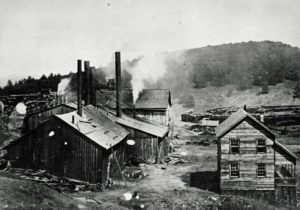NEW APPALACHIAN MOMENTS BLOG POST!!!
From Scott Ballard
Welcome to Digging into Ashe County History Part Two. In Part One we introduced mining for iron at the famous (or infamous) Ore Knob mine. This mine held secrets back then, and still does today. Read on.
After closing in the 1860s, two capitalists from Baltimore were ready to give the mine another go about 10 years later. They greatly expanded the operation, to the point that the population of the village surrounding the mine swelled to 600 people, making it the largest town in the county.
 Copper was smelted on site, and the biggest customer was the Revere Copper Company in Canton, Massachusetts, where copper and its alloys, brass and bronze, were made into everything from pots and pans to church bells and cannon.
Copper was smelted on site, and the biggest customer was the Revere Copper Company in Canton, Massachusetts, where copper and its alloys, brass and bronze, were made into everything from pots and pans to church bells and cannon.
The Ore Knob mine was so large and efficient that, in 1873, France sent mining engineers to study it. They made detailed drawings of the operation, and it is from those drawings that volunteers have created the model you can see at the Ashe County Museum of History.
For 10 years the mining operation was successful, so much so that Ore Knob was the leading copper mine in the entire United States! The company was capitalized at 1.5 million in 1881 dollars…or $40 million dollars today. But the good times didn’t last, as again the up and down cycle ran its course. Massive copper deposits in Michigan, Idaho and Montana were discovered, and the operators at Ore Knob couldn’t make a profit when the price fell 50% to just 6 cents a pound.
Later efforts to reopen the mine in 1900, 1917 and 1927 failed. The mine finally fell into the hands of a local group of businessmen, including renowned local lawyer Tam Bowie. They, in turn, found a buyer, a Floridian named Robert Lassiter, who had made his fortune selling the sunshine state’s most available resource: sand…literally…
He bought the mine for $36,000. This new buyer had connections however…and he more than quadrupled his money, flipping the mine for $150,000 in the early 1950’s.
Keen on making their investment pay off, the new owners cleaned out the old mine shafts and with a labor force of 225 men, working non-stop, they produced 35 loads of copper ore concentrate per month. And just as Meredith Ballou had complained about the copper adulterating the iron at Ore Knob, the new owners discovered that there was a good amount of other metals at Ore Knob mixing in with the copper…(wait for it!)…things like gold and silver… so much so that it’s said that the monies made from gold and silver completely paid for the mine’s operating costs so that copper itself became pure profit.
By some estimates over 9,000 ounces of gold was brought to the surface at Ore Knob…and for those of you keeping score at home, that is over 10 million (in today’s dollars) of the precious metal they weren’t even looking for when mining. The mine also yielded nearly 150,000 ounce of silver and 31,000 TONS of copper.
But history again repeated itself after another sale of the mine, when the new owners soon discovered the vertical shafts, now well over 1,000 feet straight down, had, in their words, “played out.”
Those empty shafts became ideal spots for people to “disappear” as regional crime gangs discovered…and the Ore Knob Mine Murders brought the wrong kind of attention to this rural county. It’s believed that the, now closed off and filled in Ore Knob mine shafts, hold many more secrets, perhaps forever, sealed hundreds of feet underground. More on all of that in a future post!
If you have a comment or related story, please share in the comments section!

